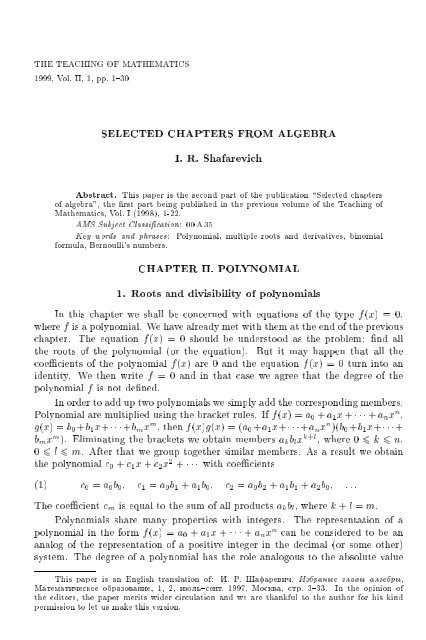SELECTED CHAPTERS FROM ALGEBRA I. R. Shafarevich Preface
SELECTED CHAPTERS FROM ALGEBRA I. R. Shafarevich Preface
SELECTED CHAPTERS FROM ALGEBRA I. R. Shafarevich Preface
Create successful ePaper yourself
Turn your PDF publications into a flip-book with our unique Google optimized e-Paper software.
THE TEACHING OF MATHEMATICS1999, Vol. II, 1, pp. 1{30<strong>SELECTED</strong> <strong>CHAPTERS</strong> <strong>FROM</strong> <strong>ALGEBRA</strong>I. R. <strong>Shafarevich</strong>Abstract. This paper is the second part of the publication \Selected chaptersof algebra", the rst part being published in the previous volume of the Teaching ofMathematics, Vol. I (1998), 1-22.AMS Subject Classication: 00 A 35Key words and phrases: Polynomial, multiple roots and derivatives, binomialformula, Bernoulli's numbers.CHAPTER II. POLYNOMIAL1. Roots and divisibility of polynomialsIn this chapter we shall be concerned with equations of the type f(x) = 0,where f is a polynomial. We have already met with them at the end of the previouschapter. The equation f(x) = 0 should be understood as the problem: nd allthe roots of the polynomial (or the equation).But it may happen that all thecoecients of the polynomial f(x) are 0 and the equation f(x) = 0 turn into anidentity. We then write f = 0 and in that case we agree that the degree of thepolynomial f is not dened.In order to add up two polynomials we simply add the corresponding members.Polynomial are multiplied using the bracket rules. If f(x) =a 0 + a 1 x + + a n x n ,g(x) =b 0 +b 1 x++b m x m , then f(x)g(x) =(a 0 +a 1 x++a n x n )(b 0 +b 1 x++b m x m ). Eliminating the brackets we obtain members a k b l x k+l , where 0 6 k 6 n,0 6 l 6 m. After that we group together similar members. As a result we obtainthe polynomial c 0 + c 1 x + c 2 x 2 + with coecients(1) c 0 = a 0 b 0 c 1 = a 0 b 1 + a 1 b 0 c 2 = a 0 b 2 + a 1 b 1 + a 2 b 0 ...The coecient c m is equal to the sum of all products a k b l , where k + l = m.Polynomials share many properties with integers. The representation of apolynomial in the form f(x) =a 0 + a 1 x + + a n x n can be considered to be ananalog of the representation of a positive integer in the decimal (or some other)system. The degree of a polynomial has the role analogous to the absolute valueThis paper is an English translation of: I. R. Xafareviq, Izbranye glavy algebry,Matematiqeskoe obrazovanie, 1, 2, il~{sent. 1997,Moskva, str. 3{33. In the opinion ofthe editors, the paper merits wider circulation and we are thankful to the author for his kindpermission to let us make this version.
















